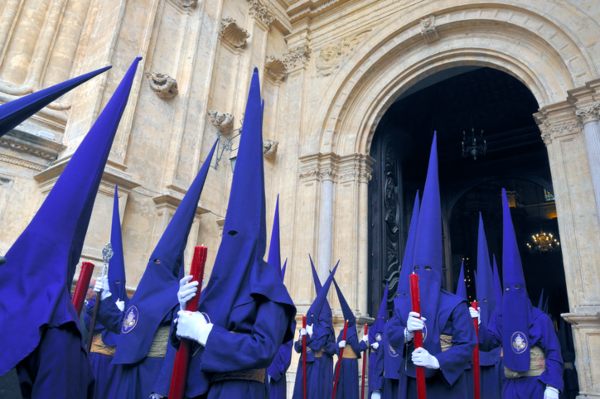In some European countries these days, Easter can pass by almost unnoticed – except for the Easter eggs. Not so in Spain. Easter celebrations in Spain are very important and it’s well-worth understanding more about the religious and not-so-religious traditions.
Easter celebrations in Spain
Spanish people really know how to mark an occasion. What often impresses foreigners is the extent to which the whole family usually gets involved and the pageant that surrounds almost every event. However, it’s this very same pageantry that can make it difficult for those who aren’t native born, to understand what is actually going on.
Easter is no exception. Over the period of at least a week, visitors to Spain can suddenly find themselves caught up in one of the many daily Easter celebrations in Spain, mainly processions. Each one is different, but there are characteristics in common and knowing what these are will help you appreciate what it is you’re seeing and a little of what it signifies.
Welcome to Semana Santa
Easter is Semana Santa (Holy Week) in Spain. However, you might also hear it called Pascua which in fact refers to the resurrection of Jesus Christ. It is celebrated at the same time across Europe but whereas in most countries Easter Sunday and Good Friday are perhaps the only really acknowledged days, in Spain every day throughout the week calls for a procession.
The processions that take place in almost every town, city and even village, tell the Easter story and are very ceremonial occasions. If you do take the time to watch one you will see the ‘pasos’ or floats on which there are religious images and statues surrounded by flowers. These are carried with reverence down the allocated streets by the Costaleros. The Costaleros are the men who carry the pasos and they belong to Cofradias or brotherhoods.
The procession is relatively slow and it’s not surprising given that the pasos can weigh around 1,500 kilos. They are carried according to a rhythm and occasionally placed down on the ground whilst the Costaleros gather breath and the procession catches up with itself.
Easter processions in Spain
You will need to check the itinerary for your particular town, however, it is likely that the Easter celebrations in Spain will begin with the palms blessing procession on the Sunday before Easter Sunday. This is also the day when you may spot the ‘mantillas’ which is the traditional costume and headwear worn by women. You will recognise the black veil which is balanced high on the back of the women’s heads.

Although there are processions every day there are some that you should look out for in particular. On Maundy Thursday is the silent procession followed by that of the Christ of Calvery. In contrast, there is a noisy procession on the Saturday which includes plenty of drums and to which, in some towns, you can bring your own and join in.
The Good Friday procession is called the Holy Burial procession and is perhaps the main one to watch. In Torrevieja, an international pasos called the Garden of Olives is carried by around 100 Costaleros of all nationalities. Another procession takes place on the Sunday and the final one is usually scheduled for the Monday.
A giant cross is carried at the front of the procession and they are usually accompanied by music and traditional marching bands are still a feature of this kind of parade in most Spanish towns. Sweets are often thrown by participants and local children know to bring a bag in which to collect them as they are flung into the crowd. Foreigners can sometimes be a little taken aback by the unusual costumes of those participating. Many of them are dressed in the traditional capirote which is a tall conical hat that covers the face and gives them a rather sinister appearance. The hat is a sign of penance which is an important feature of Easter celebrations in Spain.

Easter celebrations in Spain: the preparations
As you can imagine, such a dignified and traditional event requires months of preparation. It also demands large spaces in which the pasos can be kept. It is not unusual for a town or city to have a Semana Santa Museum and storage area. In some cases you are able to visit these at other times of the year to inspect the statues and effigies. In other cases it is simply somewhere to store the giant floats until the following year. As Easter approaches, these are then brought out of storage and may be accommodated temporarily in a tent close to the designated route.
Each Cofradías (brotherhood or Guild) has their particular pasos and they must practice before the processions to ensure that they keep in-step and on time. In larger towns and cities there can be hundreds of Costaleros and although men are usually involved in the carrying of the pasos, women accompany them along the ceremonial route.
Where to visit Easter processions
Although every town will have its own processions, some are more inspiring than others. If you are based in the Alicante region we recommend that you visit either Elche, Orihuela or Crevillente to watch their Easter celebrations. Elche and Orihuela, in particular, are traditional Spanish towns steeped in history. Here you can fully appreciate the importance of this annual religious festival.
No comments yet
There are no comments on this post yet.







Leave a comment